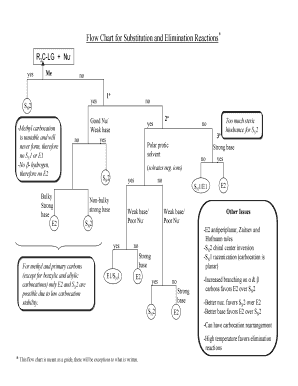Loading

Get Flow Chart For Substitution And Elimination Reactions*
How it works
-
Open form follow the instructions
-
Easily sign the form with your finger
-
Send filled & signed form or save
How to fill out the Flow Chart for substitution and elimination reactions online
Filling out the Flow Chart for substitution and elimination reactions is a critical step for understanding reaction pathways in organic chemistry. This guide provides clear instructions on how to complete the form effectively and accurately.
Follow the steps to fill out the flow chart efficiently.
- Click the ‘Get Form’ button to obtain the flow chart and open it in your preferred online editor.
- Begin by identifying the starting material, which is typically represented as R3C-LG. This will guide you on which pathway to explore for substitution or elimination.
- Determine if the substrate is primary, secondary, or tertiary. This classification influences whether you will proceed with SN2, SN1, E2, or E1 reactions based on stability and steric hindrance.
- Assess if the base is bulky or non-bulky and whether it is a strong or weak base. This differentiation is crucial in deciding between SN2 and E2 reactions.
- Evaluate the type of nucleophile (Good Nu or Weak base/Poor Nu) to determine the pathway. This decision will impact your results and should align with the characteristics of the substrate.
- Consider the solvent used; polar protic solvents can stabilize or destabilize the intermediate steps of the reactions, thus influencing the final result.
- Take note of other issues such as stereochemistry and the possibility of carbocation rearrangement as they can affect the reaction pathway.
- Once you have filled in all applicable sections and are satisfied with the inputs, save your changes to the flow chart. You may now choose to download, print, or share the completed form.
Complete your flow chart online today for a comprehensive understanding of substitution and elimination reactions.
E2: favored by a strong base. SN2: favored by a good nucleophile (relatively weaker base) SN1/E1: It is hard to separate SN1 and E1 completely apart, because they both go through carbocation intermediates, and are favored by poor nucleophile/weak base, for example, H2O or ROH (solvolysis).
Industry-leading security and compliance
US Legal Forms protects your data by complying with industry-specific security standards.
-
In businnes since 199725+ years providing professional legal documents.
-
Accredited businessGuarantees that a business meets BBB accreditation standards in the US and Canada.
-
Secured by BraintreeValidated Level 1 PCI DSS compliant payment gateway that accepts most major credit and debit card brands from across the globe.


